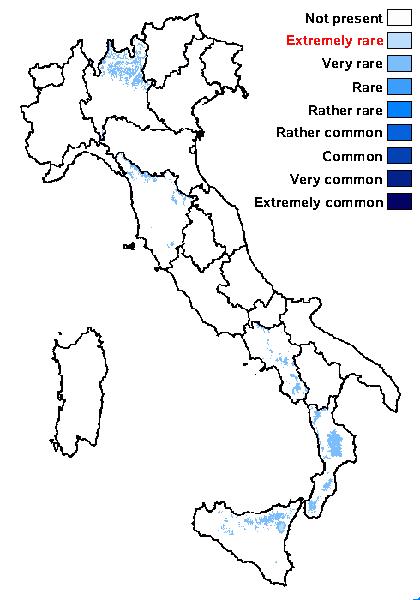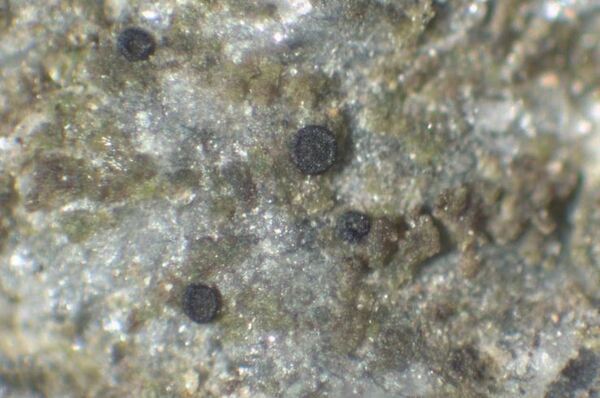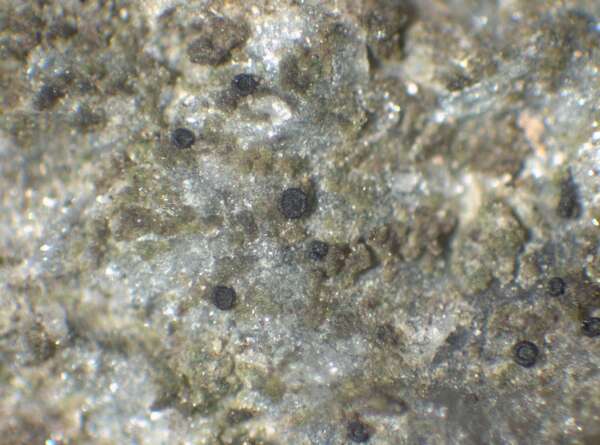Caelochroma atomarioides (Müll.Arg.) M.Svenss., S.Ekman & M.Westb.
Taxon, https://doi.org/10.1002/tax.70069: 10, 2025. Basionym: Lecidea atomarioides Müll. Arg. - Flora, 57: 187, 1874.
Synonyms: Catillaria atomarioides (Müll. Arg.) H. Kilias; Catillaria microcarpa R. Sant.
Distribution: N - Lomb (Herb. Nascimbene 2664). C - Tosc (Tretiach & al. 2008). S - Camp (Garofalo & al. 2010), Cal (UPS-L111515). Si (Iacolino & Ottonello 2006).
Description: Thallus crustose, thinly episubstratic, continuous to rimose-areolate, grey to almost black, turning greenish when wet, often delimited by a thin, dark prothallus, or inapparent and appearing as a small, dark stain. Areoles, when developed, scattered 0.15-0.25 mm wide, flat to slightly convex, smooth. Apothecia lecideine, round, black (the disc turning brown when wet), 0.1-0.2(-0.3) mm across, sessile and constricted at base, with a flat to finally convex disc and a thin, raised, finally sometimes excluded proper margin. Proper exciple green-black throughout, N+ purple; epithecium dark brown to green-black, 5-10 µm high, N- or N+ purple; hymenium colourless, 30-40(-45) µm high, I+ blue turning reddish; paraphyses simple or sparingly branched in upper part, lax, 1.5-2 µm thick at base, the apical cells capitate, up to 5 µm wide, with a dark brown to black cap; hypothecium colourless, 25-50 µm high. Asci 8-spored, cylindrical-clavate, with a K/I+ blue outer coat and a K/I+ uniformly blue apical dome, Catillaria-type. Ascospores 1-septate, hyaline, oblong-ellipsoid to ovoid, 7-12(-15) x 2-4 µm. Photobiont chlorococcoid, the cells 7-19 µm wide. Spot tests: thallus K-, C-, KC-, P-, UV-. Chemistry: without lichen substances. Note: an inconspicuous lichen found on steeply inclined surfaces of hard siliceous rocks in humid situations, mostly in upland areas; very much overlooked and certainly more widespread in Italy.
Growth form: Crustose
Substrata: rocks
Photobiont: green algae other than Trentepohlia
Reproductive strategy: mainly sexual
Pioneer species
Commonnes-rarity: (info)
Alpine belt: absent
Subalpine belt: very rare
Oromediterranean belt: extremely rare
Montane belt: very rare
Submediterranean belt: absent
Padanian area: absent
Humid submediterranean belt: absent
Humid mediterranean belt: absent
Dry mediterranean belt: absent

Predictive model
Herbarium samples
Growth form: Crustose
Substrata: rocks
Photobiont: green algae other than Trentepohlia
Reproductive strategy: mainly sexual
Pioneer species
Commonnes-rarity: (info)
Alpine belt: absent
Subalpine belt: very rare
Oromediterranean belt: extremely rare
Montane belt: very rare
Submediterranean belt: absent
Padanian area: absent
Humid submediterranean belt: absent
Humid mediterranean belt: absent
Dry mediterranean belt: absent

Predictive model
| Herbarium samples |
 DOLICHENS
DOLICHENS






